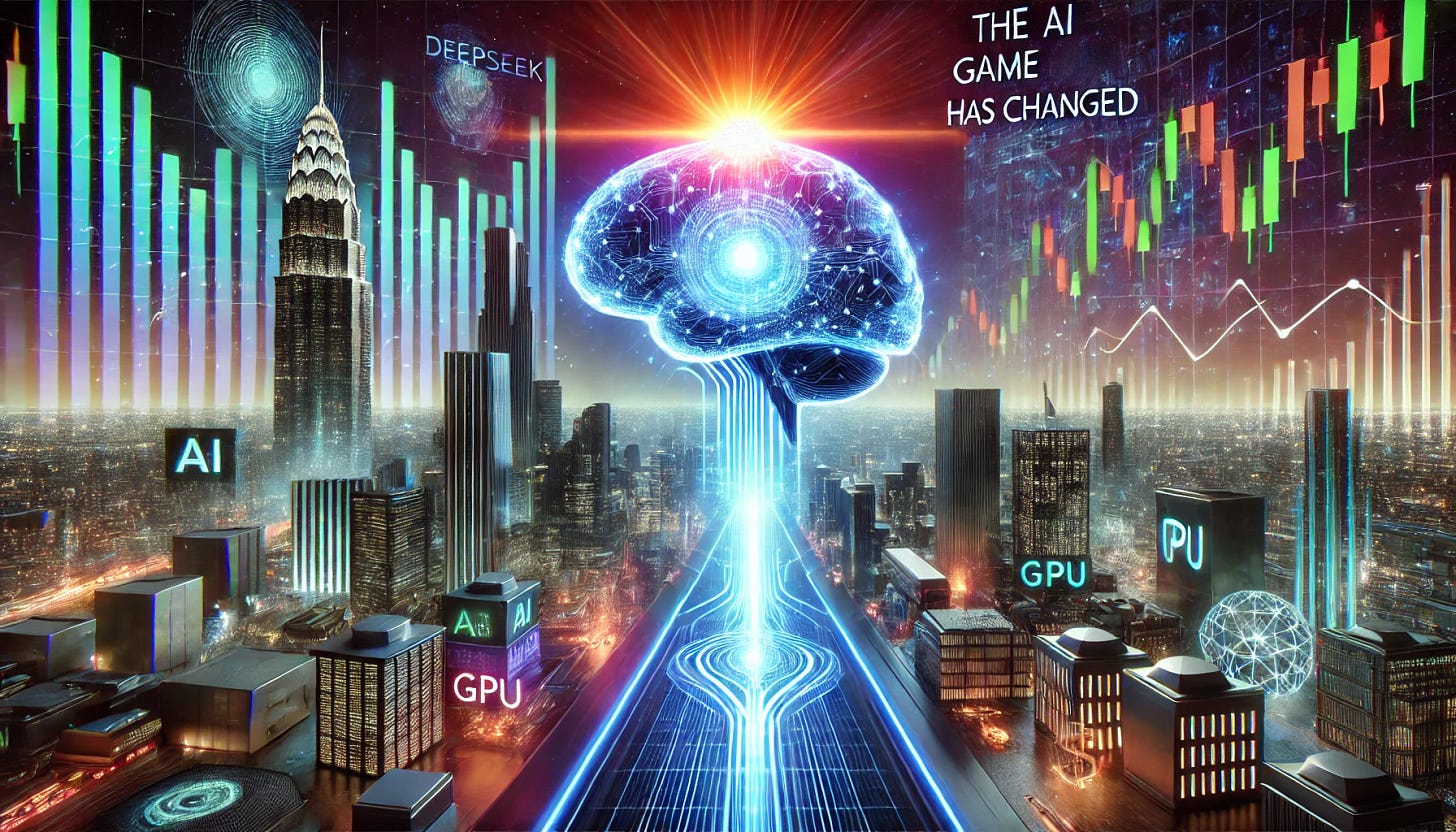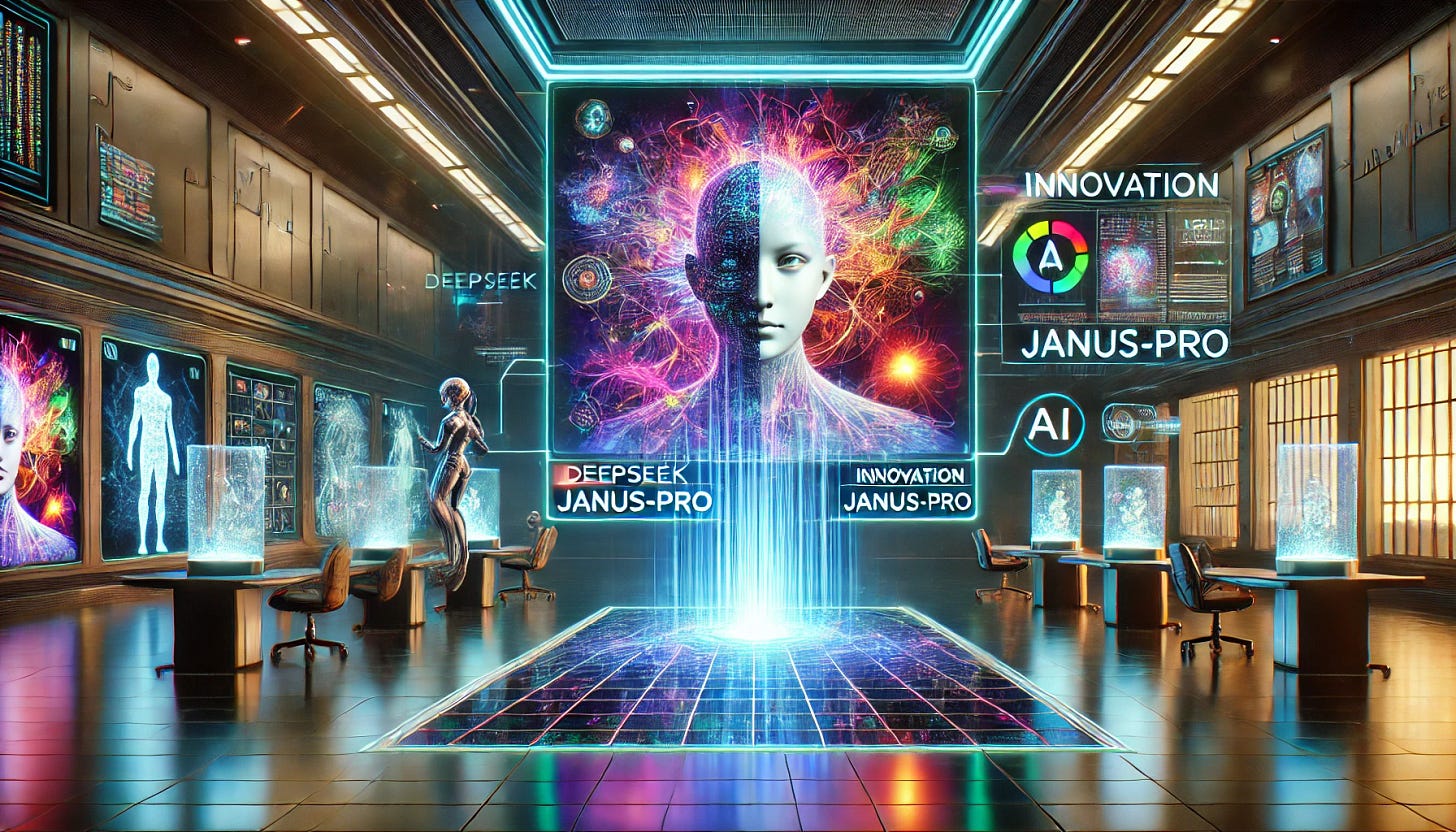Geeky Weekend Digest | 01.02.2025
In this weekend’s Geeky Weekend Digest: DeepSeek’s AI shakes up the industry, Janus-Pro challenges DALL·E, and OpenAI probes data misuse.
Step into the future with this week’s Geeky Weekend Digest. We’re uncovering the latest in AI, pioneering discoveries, and the bold vision of Terra 2.0. From cutting-edge tools to paradigm-shifting ideas, explore the innovations shaping the next era of human and technological evolution. Whether you're a dreamer, an innovator, or a disruptor, get ready for a weekend of fresh insights and transformative possibilities.
In this weekend's Geeky Weekend Digest…
A small Chinese AI startup has sent shockwaves through the industry, challenging the dominance of OpenAI and NVIDIA with cost-effective innovation. DeepSeek’s R1 model is disrupting assumptions about AI development costs, and now the company has launched a new multimodal image model. Meanwhile, controversy brews as Microsoft and OpenAI probe potential misuse of their data by DeepSeek-linked groups. Let’s dive into this AI drama.
DeepSeek’s AI Disruption: The Game Has Changed
A major technological shift is underway. DeepSeek, a small Chinese AI startup, has rattled the global AI landscape with R1, an AI model that rivals OpenAI’s ChatGPT at a fraction of the cost. The financial and strategic implications are enormous—industry leaders are reeling, stock markets are reacting, and new questions about AI development are surfacing.
Key Highlights:
A Cost Revolution: DeepSeek developed R1 with just $5–6M, using 2,000 less-advanced GPUs, while OpenAI’s ChatGPT required billions in funding and 100,000 GPUs.
Efficient Innovation: The company introduced three key breakthroughs—optimised precision, multi-token processing, and expert specialisation—to slash costs while maintaining performance.
Open-Source Impact: Unlike OpenAI’s proprietary models, R1 is open-source, allowing broader access and accelerating AI development.
Stock Market Shock: NVIDIA shares fell 17% following the announcement, wiping out $6B in value, as investors questioned the long-term need for expensive AI hardware.
A New AI Race: Marc Andreessen called DeepSeek’s rise “AI’s Sputnik moment,” likening it to a seismic shift in technological power.
Why It Matters
DeepSeek’s success challenges long-held assumptions that AI breakthroughs require massive resources and elite teams. By proving that high-performance AI can be developed on a shoestring budget, the company has signalled the start of a new era—one where agility and innovation might outpace brute-force spending. This has major implications for AI accessibility, competition, and geopolitical strategy.
Closing Thoughts
Just as Amazon disrupted retail and Uber transformed transportation, DeepSeek may be the catalyst for a fundamental AI industry shift. The implications extend beyond tech—healthcare, finance, and education could be next in line for disruption. The democratisation of AI is here, and the playing field just got a whole lot more interesting.
DeepSeek’s Janus-Pro: The Next Leap in AI Image Generation
Following its R1 success, DeepSeek has unveiled Janus-Pro, a new open-source multimodal AI model that outperforms established leaders like OpenAI’s DALL-E 3 and Stability AI’s Stable Diffusion. This marks yet another milestone for the disruptive startup.
Key Highlights:
State-of-the-Art Performance: Janus-Pro surpasses DALL-E 3 and Stable Diffusion in industry benchmarks for image quality and accuracy.
Scalable AI: The model is available in both 1B and 7B parameter versions, allowing for a wide range of applications.
Open-Source Accessibility: Released under an MIT license, developers can freely use and adapt the model for commercial use.
Reinforcing DeepSeek’s Dominance: The launch follows the R1 breakthrough, further challenging U.S. AI leaders.
Why It Matters
DeepSeek is proving it can consistently push AI forward without the excessive costs traditionally associated with model development. The success of R1 and now Janus-Pro signals that China’s AI sector is making serious inroads into what was previously U.S.-dominated territory. The open-source nature of these models also means that innovation will spread faster, potentially accelerating AI adoption and development worldwide.
Closing Thoughts
DeepSeek has now made its mark in both text-based AI and image generation. If this momentum continues, the startup could redefine the AI landscape in ways that established players never anticipated. It’s not just about efficiency—it’s about fundamentally changing the way AI is built and distributed.
DeepSeek Faces Scrutiny Over OpenAI Data Use
With DeepSeek’s rapid ascent, controversy has followed. Microsoft and OpenAI are investigating whether a group linked to DeepSeek improperly obtained OpenAI’s proprietary data, raising concerns about AI security, intellectual property, and ethical competition.
Key Highlights:
Microsoft’s Alarm: Microsoft researchers flagged suspicious data extraction via OpenAI’s API, which could violate OpenAI’s terms of service.
Allegations of AI ‘Distillation’: U.S. officials, including AI policy leader David Sacks, claim DeepSeek may have used OpenAI’s model outputs to train R1—a controversial but not unprecedented practice.
Stock Market Fallout: The investigation contributed to a market selloff, wiping out nearly $1 trillion in AI-related stock value.
Altman’s Take: OpenAI CEO Sam Altman called R1 an “impressive model” but reiterated that OpenAI’s upcoming releases would surpass it.
Why It Matters
If DeepSeek used OpenAI’s models for training without authorisation, this raises ethical and legal questions about AI development in an open-source age. It also highlights broader concerns about the security of AI intellectual property. As the U.S. and China compete for AI dominance, these issues could shape future regulation and trade policy.
Closing Thoughts
While OpenAI investigates potential IP violations, DeepSeek’s innovations continue to upend the industry. Whether R1 was built independently or leaned on OpenAI’s work, the end result is clear: the AI race has intensified, and old rules are being rewritten.
One More Thing…
A Deep Dive into DeepSeek
With DeepSeek making headlines and shaking up the AI industry, you might be wondering what this all means for the future of artificial intelligence. To explore the impact of DeepSeek’s R1 and its implications for AGI, computing, and market disruption, here are three insightful video recommendations:
🔹 Why Every Phone Will Have AGI by 2026 – DeepSeek R1 Proves It's Coming!
📺 David Shapiro
👉 Watch here
This video delves into why DeepSeek’s efficiency breakthrough could lead to AI models running on consumer devices far sooner than expected, potentially decentralising AGI development.
🔹 DeepSeek – The Chinese AI That Crashed The Markets
📺 Matt Wolfe
👉 Watch here
A comprehensive breakdown of DeepSeek’s rise, the technology behind R1 and Janus-Pro, and the market implications. Topics include:
What makes DeepSeek different from OpenAI and Google
Why DeepSeek caused a financial panic
Arguments for and against concerns over DeepSeek’s dominance
How you can test DeepSeek’s models yourself
If you’re looking to go beyond the headlines and truly understand what’s happening in the AI revolution, these videos offer a fascinating perspective.
🔹 DeepSeek vs. OpenAI – The State of AI w/ Emad Mostaque & Salim Ismail
📺 Moonshots EP #146
👉 Watch here
In this episode, Emad Mostaque, Salim Ismail, and Peter H. Diamandis explore the DeepSeek revolution, the AI arms race between China and the U.S., and the broader implications for the future of artificial intelligence. A must-watch for anyone following AI geopolitics and industry shifts.
If you’re looking to go beyond the headlines and truly understand what’s happening in the AI revolution, these videos offer a fascinating perspective.
Final Thoughts
DeepSeek’s rise signals a seismic shift in AI development, proving that innovation isn’t just about resources but also about efficiency and strategy. With its cost-effective breakthroughs, the AI playing field is evolving rapidly, sparking both excitement and concern across the industry. As new models like Janus-Pro push boundaries and OpenAI investigates potential data misuse, the AI arms race is heating up. What happens next will define the future of AI accessibility, competition, and regulation. One thing is certain—this is just the beginning.
What’s Your Take?
Which part of this AI shake-up intrigued you the most? I’d love to hear your thoughts—drop me a message on 𝕏 @frankdasilva.
If you found this edition thought-provoking, consider supporting MyGeekSpace as a paid subscriber for exclusive content and in-depth discussions. Your support helps drive bold projects and future-focused research. Want even more behind-the-scenes insights? Join me on Patreon for deeper dives and exclusive conversations.
Stay curious, stay inspired, and I’ll see you next weekend for more cutting-edge discoveries!













